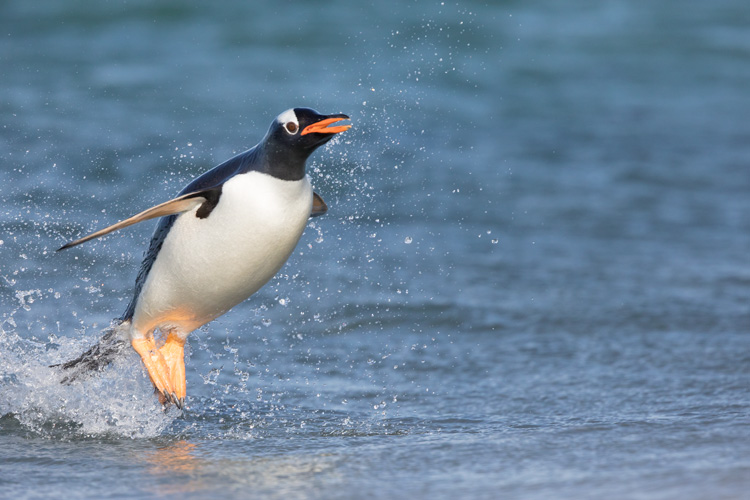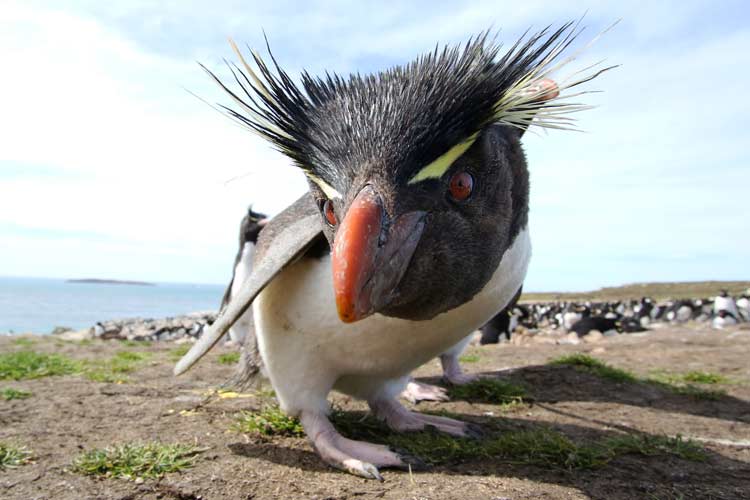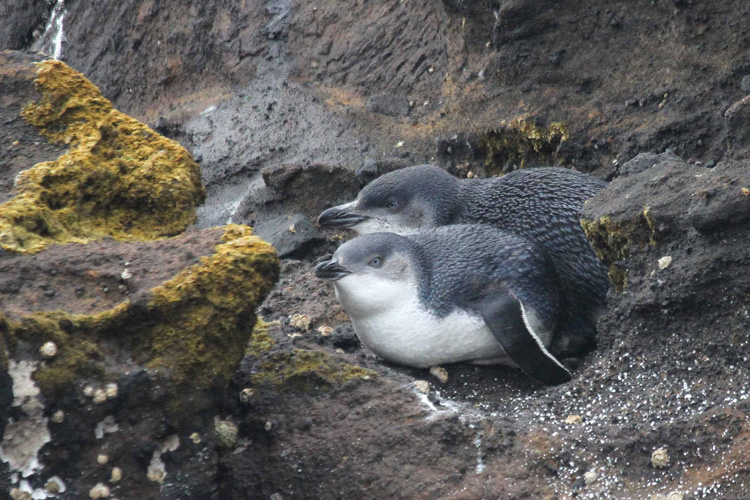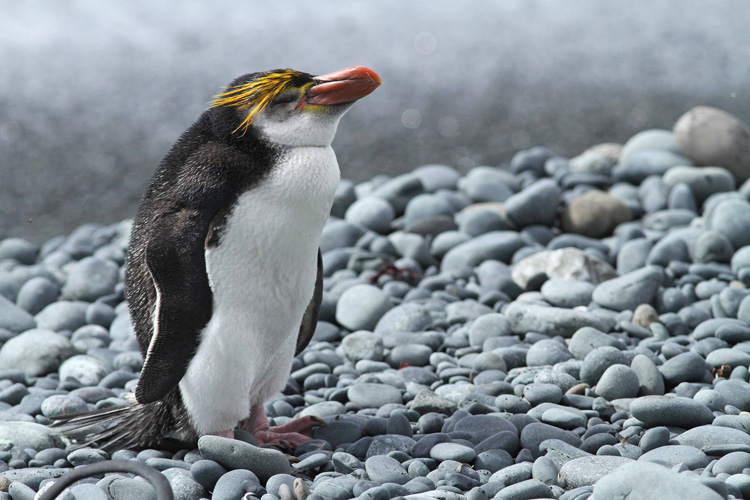Penguins are Aussies. Or are they Kiwis?
First genome comparisons give insight into penguin origins and evolution
August 17, 2020

A gentoo penguin exiting the water. (Photo courtesy of Keith Barnes/www.pittaconsulting.com)
From the four-foot-tall emperor penguin to the aptly named foot-long little penguin, these unique flightless birds have invaded habitats from Antarctica to the equator, not to mention the hearts of the public.
A comparison of the full genomes of 18 recognized species of penguins provides clues to how they achieved this success — though not their adorability — over tens of millions of years, through warm and cold climate swings. It also cautions that today’s rapidly changing climate may be too much for them.
“We are able to show how penguins have been able to diversify to occupy the incredibly different thermal environments they live in today, going from 9 degrees Celsius (48 F) in the waters around Australia and New Zealand, down to negative temperatures in Antarctica and up to 26 degrees (79 F) in the Galápagos Islands,” said Rauri Bowie, professor of integrative biology at the University of California, Berkeley, and curator in the Museum of Vertebrate Zoology (MVZ) at Berkeley. “But we want to make the point that it has taken millions of years for penguins to be able to occupy such diverse habitats, and at the rate that oceans are warming, penguins are not going to be able to adapt fast enough to keep up with changing climate.”
The researchers established conclusively that penguins arose in the cool coastal regions of Australia and New Zealand, not frigid Antarctica, as many scientists thought, and they pinpoint the origin of penguins at about 22 million years ago.

A curious rockhopper penguin. (Photo courtesy of Keith Barnes/www.pittaconsulting.com)
Despite their success in spreading widely throughout the Southern Hemisphere, many penguin populations are now threatened. Breeding colonies of emperor penguins in Antarctica have had to relocate because of receding sea ice, while last year saw mass mortality of Adélie penguin chicks on the continent. Galápagos penguin populations are declining as warm El Niño events become more common. In New Zealand, populations of little and yellow-eyed penguins must be fenced off to protect them from the depredations of feral cats, while African penguin populations are declining drastically as the waters off southern Africa warm.
“We saw, over millions of years, that the diversification of penguins decreased with increasing temperature, but that was over a longtime scale,” said Juliana Vianna, associate professor of ecosystems and environment at the Pontifical Catholic University of Chile in Santiago. “Right now, changes in the climate and environment are going too fast for some species to respond to the climate change.”
Vianna is first author of a paper with Bowie and other colleagues describing their findings that will be published online this week in the journal Proceedings of the National Academy of Sciences.
Where did penguins come from?
For the study, Vianna, Bowie and colleagues at museums and universities around the world gathered blood and tissue samples from 22 penguins representing 18 species and then sequenced and analyzed their whole genomes to chart penguin movement and diversification over the millennia.

Juliana Vianna among a group of rockhopper penguins. (Photo courtesy of Juliana Vianna)
Their conclusions resolve several long-standing questions: in particular, where penguins originated — along the coasts of Australia, New Zealand and nearby islands of the South Pacific — and when — 22 million years ago. The genetic evidence indicates that the ancestors of the king and emperor penguins, the two largest species, soon split off from the other penguins and moved to sub-Antarctic and Antarctic waters, respectively, presumably to take advantage of abundant food resources. This scenario is consistent with the contested hypothesis that the emperor and king penguins — the only two species in the genus Aptenodytes — are the sister group to all other penguin lineages.
“It was very satisfying to be able to resolve the phylogeny, which has been debated for a long time,” Bowie said. “The debate hinged on where, exactly, the emperor and king penguins were placed in the family tree, whether they are nested inside the tree closer to other lineages of penguins or whether they are sisters to all the other penguins, which is what our phylogeny showed and some other previous studies had suggested. And it fits with the rich fossil history of penguins.”
The other penguins diversified and spread widely across the southern oceans, after the Drake’s Passage between Antarctica and the southern tip of South America fully opened about 12 million years ago. The opening revved up the clockwise-moving Antarctic Circumpolar Current allowed these flightless birds to swim with the ocean currents throughout the southern ocean, populating both the cold sub-Antarctic islands and the warmer coastal areas of South America and Africa, where they populated to coastlines and remote islands with cold, upwelling, nutrient-rich water.
Today, penguins are found in Australia and New Zealand (yellow-eyed, little and other crested penguins), Antarctica (emperor, Adélie, gentoo and chinstrap), the tropical west coast of South America (Galápagos and Humboldt), the southern coasts of South America (Magellanic and southern rockhopper), the South Atlantic (Magellanic and Macaroni), southern Africa (African) and some in the sub-Antarctic (king, gentoo and Macaroni), Indian Ocean islands (eastern rockhopper) and sub-tropical regions (northern rockhopper).

The little or blue penguin is the smallest of the 18 recognized species. (Photo courtesy of Keith Barnes/www.pittaconsulting.com)
Using powerful analysis techniques, some developed recently to analyze historical interactions among humans and our Neanderthal and Denisovan relatives, the researchers were able to determine that several groups of penguins have interbred over the course of their evolutionary history. Through exchange of genetic material, penguins may have shared genetic traits that facilitated the diversification of penguins across the steep thermal and salinity gradients encountered in the southern oceans. The most hybridized are the rockhopper penguins and their close relatives, which experienced at least four introgressions, or transfers of genetic information, over the course of millions of years.
The team also pinpointed genetic adaptions that allowed penguins to thrive in new and challenging environments, including changes in genes responsible for regulating body temperature, which allowed them to adapt to subzero Antarctic temperatures, as well as tropical temperatures near the equator; oxygen consumption that permitted deeper dives; and osmoregulation, so they could survive on seawater without the need to find fresh water.
New analytical tools helped the researchers to infer the sizes of ancient penguin populations going back about 1 million years. Most penguin species, they found, increased to their greatest numbers as the world cooled 40,000 to 70,000 years ago during the last glaciation — many species prefer to breed on snow and ice — and some had a bump in population during the previous glaciation period 140,000 years ago.
Two species — the gentoo and the Galápagos — seem to have been declining in populations for at least the past 1 million years.
DNA from the most isolated birds on Earth
Vianna has long-running research projects on penguins in Chile and Antarctica and, for this study, obtained blood samples from many species in those areas. Colleagues in France, Norway, Brazil, Australia, the United States and South Africa supplied blood from some remote species — Norwegian colleagues provided blood from the chinstrap penguin of the Bouvet islands, for example — while Vianna and Bowie obtained blood samples from an African penguin in a colony at the California Academy of Sciences in San Francisco.

King penguins. (Photo courtesy of Aurora Fernandez)
But some species were harder to locate. The researchers were forced to rely on tissue from a preserved specimen of the yellow-eyed penguin in UC Berkeley’s MVZ, while the American Museum of Natural History in New York supplied tissue from preserved erect-crested and Fiordland penguins.
Each genome was sequenced 30 times by Illumina shotgun sequencing, which produced tiny pieces — about 150 base pairs long — of the entire genome. Vianna, who at the time was working with Bowie at UC Berkeley on a sabbatical, painstakingly aligned each piece along a reference genome that had previously been sequenced — that of the emperor penguin — as a scaffold.
“Having a reference genome is like using the cover of a puzzle box to assemble a jigsaw puzzle: You can take all your super little pieces and align them to that reference genome,” Bowie said. “We did that with each of these penguin genomes.”
The genome comparisons told them that penguins arose between 21 million and 22 million years ago, narrowing down the 10-to-40-million-year window determined previously from fossil penguins.
They also disproved a paper published last year that suggested that the closely related king and emperor penguins were a sister group to the gentoo and Adélie penguins. Instead, they found that the king and emperor penguins are the sister group to all other penguins.

Royal penguins are genetically indistinguishable from Macaroni penguins. (Photo courtesy of Keith Barnes/www.pittaconsulting.com)
Vianna and Bowie now have genome sequences of 300 individual penguins and are diving more deeply into the genetic variations within and among disparate penguin populations. They recently discovered a new lineage of penguin that awaits scientific description.
“Penguins are very charismatic, certainly,” Vianna said. “But I hope these studies also lead to better conservation.”
The work was supported by the Chilean Antarctic Institute, Fondecyt Project, GAB PIA CONICYT (ACT172065) and the U.S. National Science Foundation (DEB-1441652). Among the paper’s co-authors are Ke Bi and Cynthia Wang-Claypool of UC Berkeley and Daly Noll of Pontifical Catholic University of Chile.
RELATED INFORMATION
- Genome-wide analyses reveal drivers of penguin diversification (PNAS)
- Rauri Bowie’s lab website
- Juliana Vianna’s Molecular Biodiversity Laboratory